Effects of High Temperature on the Burst Process of Carbon Fiber/PVA Fiber High-Strength Concretes
Abstract
:1. Introduction
2. Experiment
2.1. Experimental Materials and Mixture Ratio
2.2. Molding Techniques
2.3. Experimental Apparatus
2.4. Test Method
3. Mechanical Property at Room Temperature and Working Performance
3.1. Compression Strength
3.2. Splitting Strength
3.3. Flexural Strength
3.4. Axial Compression Strength
4. Burst Process of the Test Specimens
4.1. Effect of Fiber Content
4.2. Effect of Water Content
4.3. Effect of Size of the Fiber Concrete Test Specimens
4.4. Effect of Heating Rate
5. SEM Samples
6. Conclusions
- Fiber addition will improve the high-temperature burst behavior of the high-strength concrete, and the performance of PVA is greatly different from that of carbon fiber.
- Carbon fiber can markedly improve the strength of the high-strength concrete but cannot suppress the incidence of bursting; instead, it can only change the sudden burst into a continuous weak burst. In this experiment, 0.2% carbon fiber is the optimal addition amount, but the addition of carbon fiber will reduce the burst temperature of the concrete, and the reduction is related to the amount of addition of carbon fiber in the high-strength concrete. Generally, the temperature will be 42–73 °C lower than that of the basic mix proportion.
- PVA fiber has a superb burst-suppression property; its addition can enhance the flexural strength and splitting strength of the concrete, and it has little influence on the axial compressive strength but will reduce the compressive strength of the concrete. PVA fibers will develop vaporization under high temperatures, and holes will be formed in the concrete, which can effectively release the concrete vapor pressure and suppress the incidence of concrete burst. The influence of the mixed addition of fiber on the concrete is the same as that on the PVA test specimen.
- The water content and heating rate have little influence on the burst of the PVA test specimen, but they will greatly affect the carbon fiber test specimen. A low water content will delay the initial burst time of the carbon fiber test specimen, but the burst will become fiercer. Similarly, a faster heating rate will advance the initial burst time of the carbon fiber concrete and accelerate the burst degree.
- The size of the test specimen has a great influence on the burst. For the PVA concrete test specimen, the large size test specimen burst on the surface; as for the carbon fiber test specimen, the large size test specimen delayed the initial burst time, but the burst became fiercer.
Author Contributions
Funding
Conflicts of Interest
References
- Ahmad, S.; Rasul, M.; Adekunle, S.K.; Al-Dulaijan, S.U.; Maslehuddin, M.; Ali, S.L. Mechanical properties of steel fiber-reinforced UHPC mixtures exposed to elevated temperature: Effects of exposure duration and fiber content. Compos. Part B 2018, 168, 291–301. [Google Scholar] [CrossRef]
- Kusumawardaningsih, Y.; Fehling, E.; Ismail, M.; Aboubakr, A.A.M. Tensile strength behavior of UHPC and UHPFRC. Procedia Eng. 2015, 125, 1081–1086. [Google Scholar] [CrossRef]
- Liu, Z.C.; El-Tawil, S.; Hansen, W.; Wang, F.Z. Effect of slag cement on the properties of ultra-high performance concrete. Constr. Build. Mater. 2018, 190, 830–837. [Google Scholar] [CrossRef]
- Bhanja, S.; Sengupta, B. Influence of silica fume on the tensile strength of concrete. Cem. Concr. Res. 2005, 35, 743–747. [Google Scholar] [CrossRef]
- Zhou, Z.D.; Qiao, P.Z. Durability of ultra-high performance concrete in tension under cold weather conditions. Cem. Concr. Compos. 2018, 94, 94–106. [Google Scholar] [CrossRef]
- Sun, W. Advances in research of service characteristics of modern concrete materials and structures. China Concr. 2009, 20–30. [Google Scholar] [CrossRef]
- Du, R.Y.; Huang, Q.W.; Chen, B.C. Application and study of reactive powder concrete to bridge engineering. World Bridges 2013, 41, 69–74. [Google Scholar]
- Zheng, W.Z.; Hou, X.M.; Shi, D.S.; Xu, M.X. Experimental study on concrete spalling in prestressed slabs subjected to fire. Fire Saf. J. 2010, 45, 283–297. [Google Scholar] [CrossRef]
- Kodur, V.; Dwaikat, M.; Raut, N. Macroscopic FE model for tracing the fire response of reinforced concrete structures. Eng. Struct. 2009, 31, 2368–2379. [Google Scholar] [CrossRef]
- Majorana, C.E.; Salomoni, V.A.; Mazzucco, G.; Khoury, G.A. An approach for modelling concrete spalling in finite strains. Math. Comput. Simul. 2010, 80, 1694–1712. [Google Scholar] [CrossRef]
- Xiao, J.Z.; Falkner, H. On residual strength of high-performance concrete with and without polypropylene fibers at elevated temperatures. Fire Saf. J. 2006, 41, 115–121. [Google Scholar] [CrossRef]
- Bastami, M.; Chaboki-Khiabani, A.; Baghbadrani, M.; Kordi, M. Performance of high strength concretes at elevated temperatures. Sci. Iran. A 2011, 18, 1028–1036. [Google Scholar] [CrossRef] [Green Version]
- Chaboche, J.L. Development of Continuum Damage Mechanics for Elastic Solids Sustaining Anisotropic and Unilateral Damage. Int. J. Damage Mech. 1993, 2, 311–329. [Google Scholar] [CrossRef]
- Kodur, V.K.R.; Cheng, F.P.; Wang, T.C.; Sultan, M.A. Effect of Strength and Fiber Reinforcement on Fire Resistance of High-Strength Concrete Columns. ASCE J. Struct. Div. 2003, 129, 253–259. [Google Scholar] [CrossRef] [Green Version]
- Kodur, V.K.R.; Wang, T.C.; Cheng, F.P. Predicting the fire resistance behaviour of high strength concrete columns. Cem. Concr. Compos. 2004, 26, 141–153. [Google Scholar] [CrossRef] [Green Version]
- Choe, G.; Kim, G.; Yoon, M.; Hwang, E.; Nam, J.; Guncunski, N. Effect of moisture migration and water vapor pressure build-up with the heating rate on concrete spalling type. Cem. Concr. Res. 2018, 116, 1–10. [Google Scholar] [CrossRef]
- Phan, L.T.; Lawson, J.R.; Davis, F.L. Effects of elevated temperature exposure on heating characteristics, spalling, and residual properties of high-performance concrete. Mater. Struct. 2005, 34, 83–91. [Google Scholar] [CrossRef]
- Pandey, R.N.; Srivastava, S.K.; Mikhailov, M.D. Solutions of Luikov equations of heat and mass transfer in capillary porous bodies through matrix calculus: A new approach. Int. J. Heat Mass Transf. 1999, 42, 2649–2660. [Google Scholar] [CrossRef]
- Fu, Y.F.; Li, L.C. Study on mechanism of thermal spalling in concrete exposed to elevated temperatures. Mater. Struct. 2011, 44, 361–376. [Google Scholar] [CrossRef]
- Bangi, M.R.; Horiguchi, T. Effect of fiber type and geometry on maximum pore pressures in fibre-reinforced high strength concrete at elevated temperatures. Cem. Concr. Res. 2012, 42, 459–466. [Google Scholar] [CrossRef]
- Dwaikat, M.B.; Kodur, V.K.R. Hydrothermal model for predicting fire-induced spalling in concrete structural systems. Fire Saf. J. 2009, 44, 425–434. [Google Scholar] [CrossRef]
- Tai, Y.S.; Pan, H.H.; Kung, Y.N. Mechanical properties of steel fiber reinforced reactive powder concrete following exposure to high temperature reaching 800 °C. Nucl. Eng. Des. 2011, 241, 2416–2424. [Google Scholar] [CrossRef]
- Liu, H.B.; Li, K.L.; Ju, Y.; Wang, H.J.; Wang, J.B.; Tian, K.P.; Wei, S. Explosive spalling of steel fiber reinforced reactive powder concrete subject to high temperature. Concrete 2010, 8, 6–8. [Google Scholar] [CrossRef]
- Peng, G.F.; Niu, X.J.; Cheng, K. Research on Fire Resistance of ultra-high-performance concrete: A review. Mater. Rev. 2017, 31, 17–23. [Google Scholar] [CrossRef]
- Han, C.G.; Heo, M.C.; Heo, Y.S. Improvement of residual compressive strength and palling resistance of high-strength RC columns subjected to fire. Constr. Build. Mater 2009, 23, 107–116. [Google Scholar] [CrossRef]
- Ju, Y.; Wang, L.; Liu, H.B.; Tian, K.P. An experimental investigation of the thermal spalling of polypropylene fibered reactive powder concrete exposed to elevated temperatures. Sci. Bull. 2015, 60, 2022. [Google Scholar] [CrossRef]
- Sanchayan, S.; Foster, S. High temperature behaviour of hybrid steel- PVA fiber reinforced reactive powder concrete. Mater. Struct. 2016, 49, 769–782. [Google Scholar] [CrossRef]
- Hou, X.M.; Venkatesh, K.; Zheng, W.Z. Factors governing the fire response of bonded prestressed concrete continuous beams. Mater. Struct. 2015, 48, 2885–2900. [Google Scholar] [CrossRef]
- Tao, J.; Liu, X.; Yuan, Y.; Taerwe, L. Experimental study of factors affecting the spalling of self-compacting concrete under high temperatures. China J. Civ. Eng. 2009, 42, 22–26. (In Chinese) [Google Scholar] [CrossRef]
- Luo, B.F. Study on Explosive Spalling Rules and Mechanical Properties of Reactive Powder Concrete at Elevated Temperatures; Harbin Institute of Technology: Harbin, China, 2014. [Google Scholar]
- Peng, G.F. Explosive Spalling Resistance of Ultrahigh Performance Concrete. J. Build. Mater. 2017, 20, 229–238. [Google Scholar] [CrossRef]
- Hertz, K.D. Limits of spalling of fire-exposed concrete. Fire Saf. J. 2003, 38, 103–116. [Google Scholar] [CrossRef]
- Xue, G.; Zhang, X. Effect of Steel Fiber Content on Basic Mechanical Properties of Reactive Powder Concrete. B Chin. Ceram. Soc. 2018, 37, 934–938. (In Chinese) [Google Scholar] [CrossRef]
- Li, H.Y. Experimental Study on Spalling Behaviour and Mechanical Properties of Reactive Powder Concrete after Elevated Temperatures; Harbin Institute of Technology: Harbin, China, 2014. [Google Scholar]
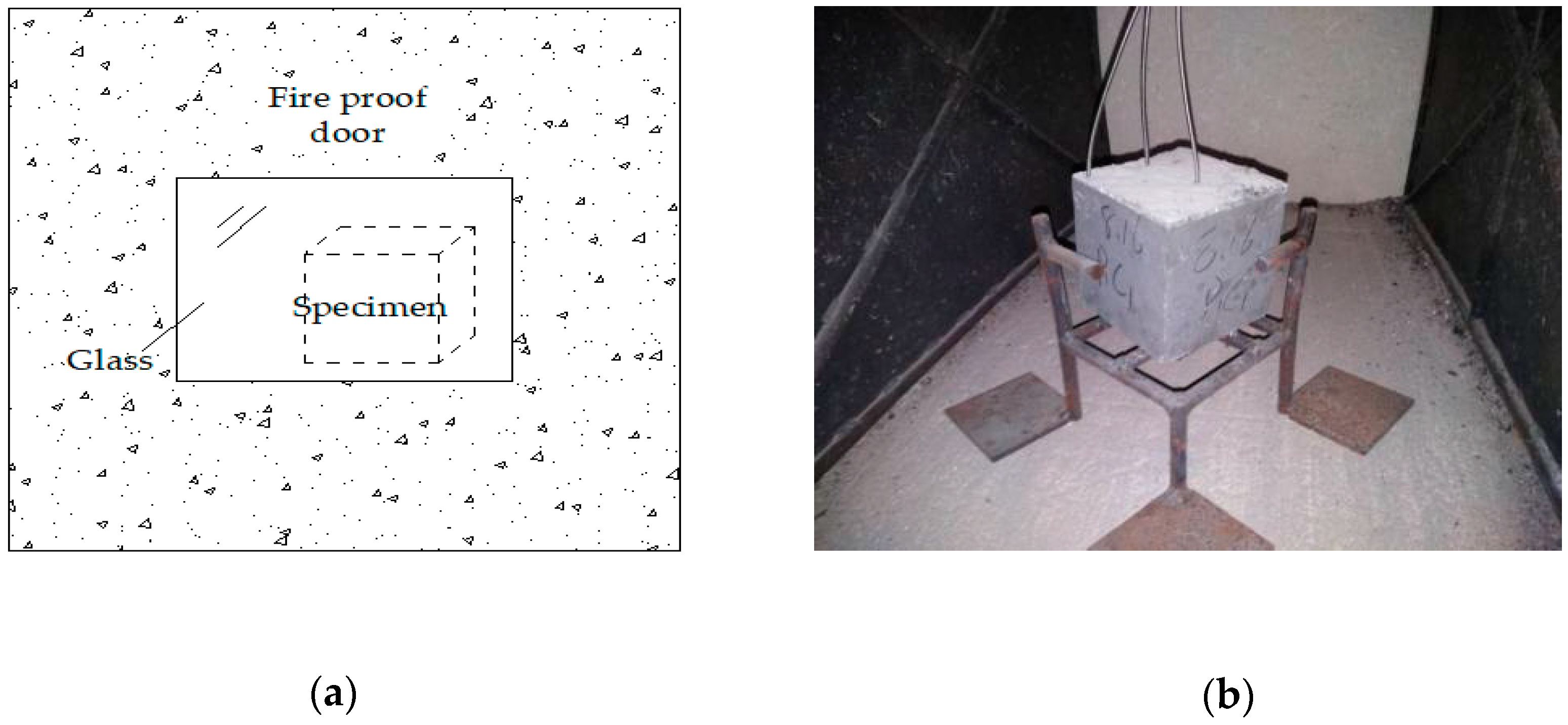
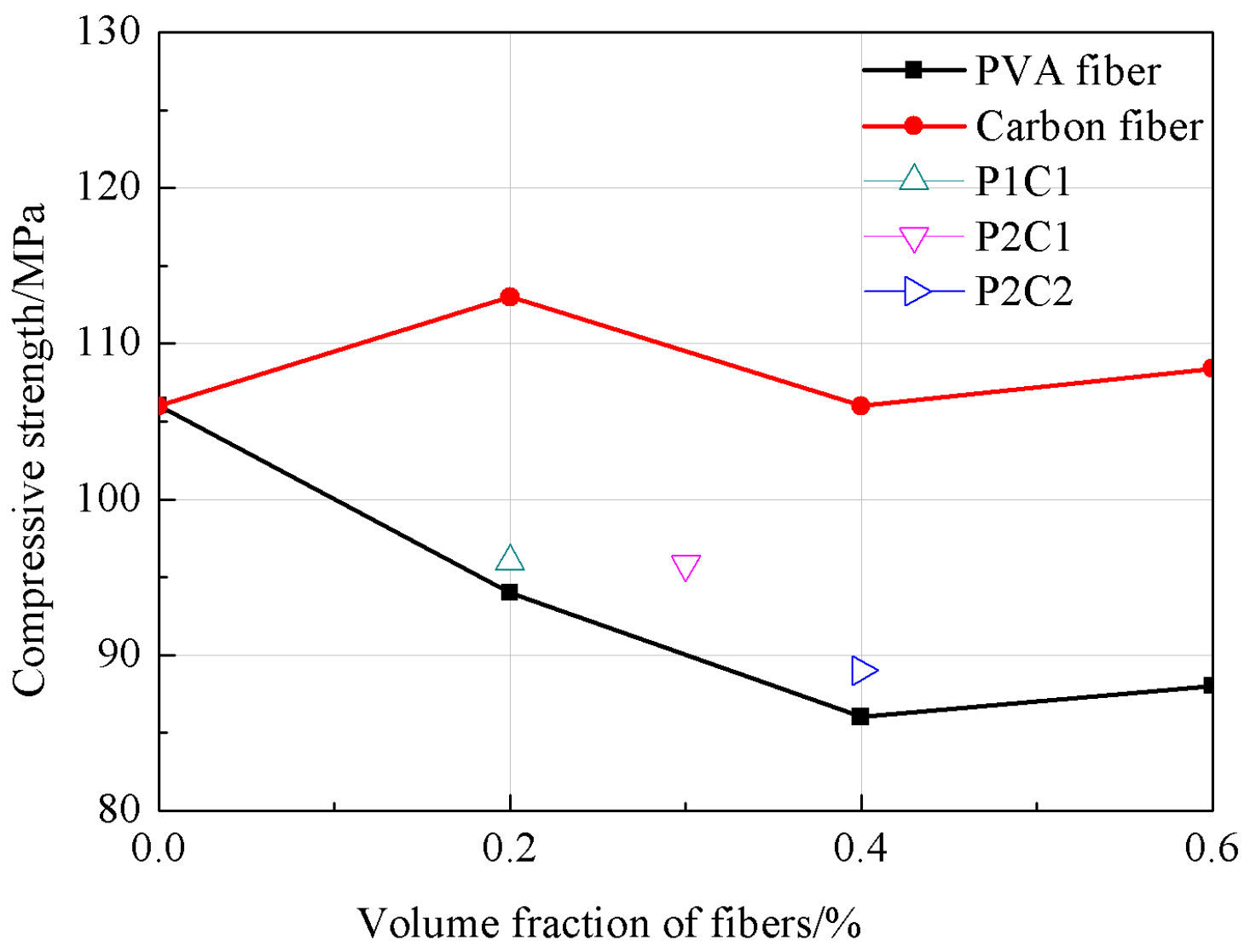
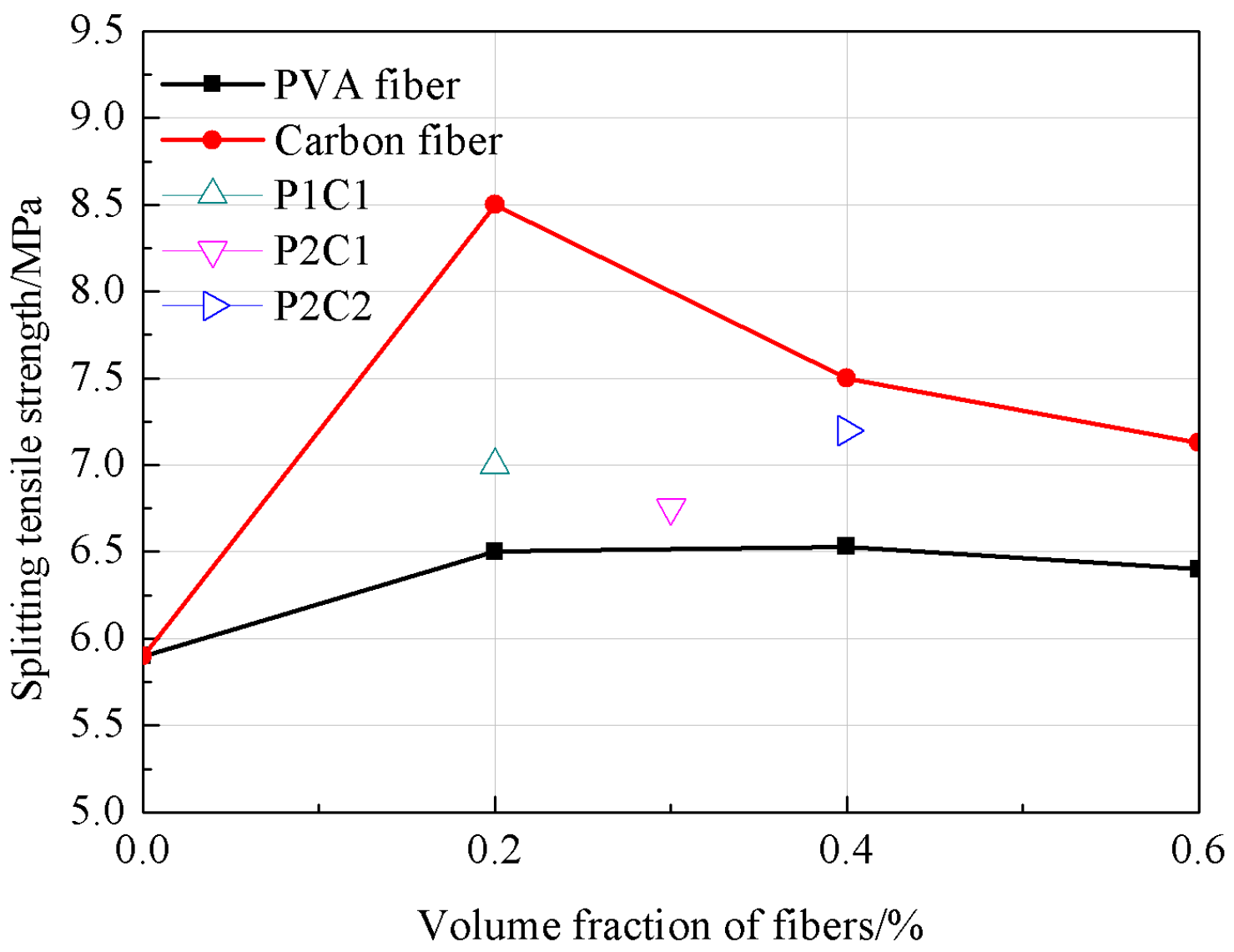
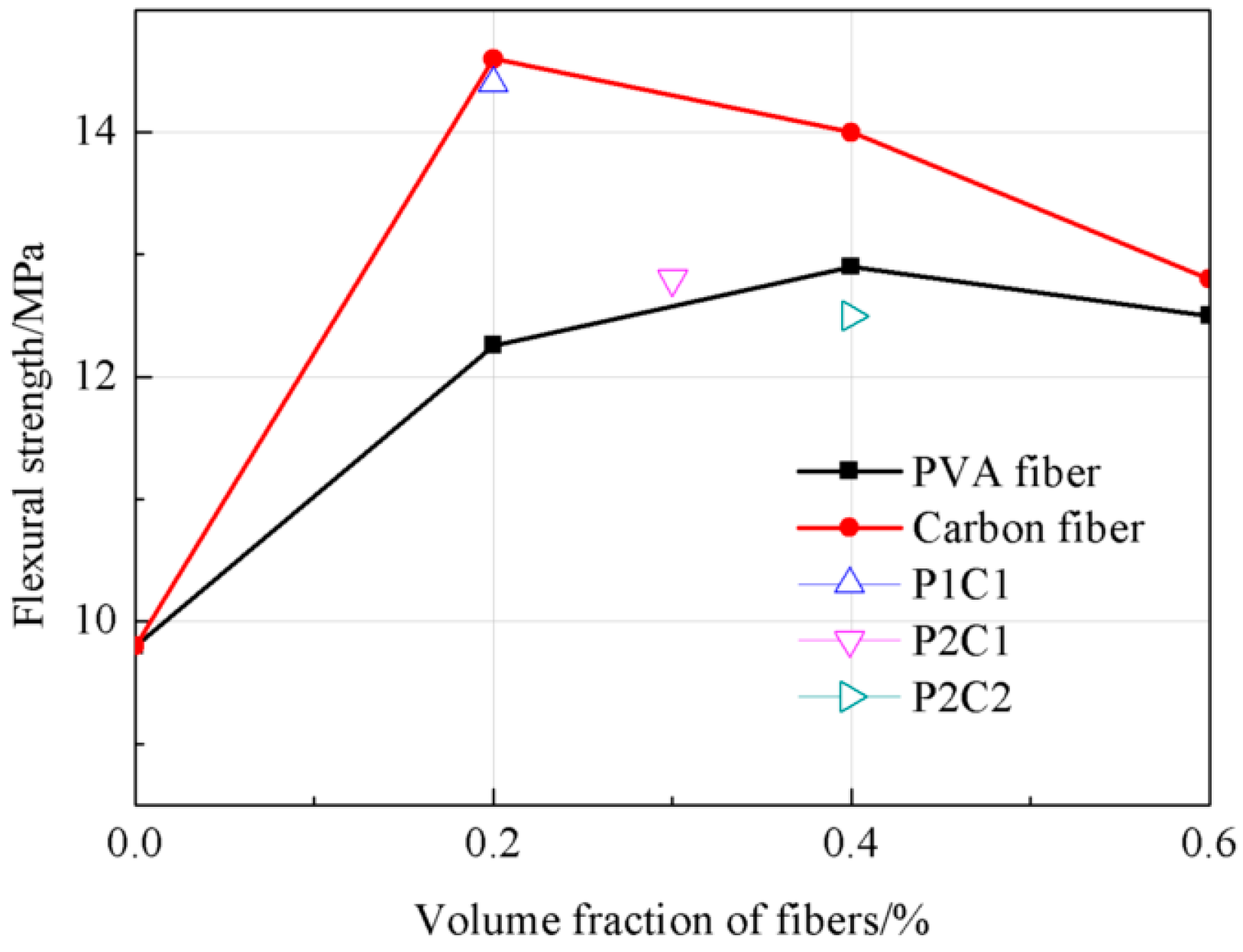
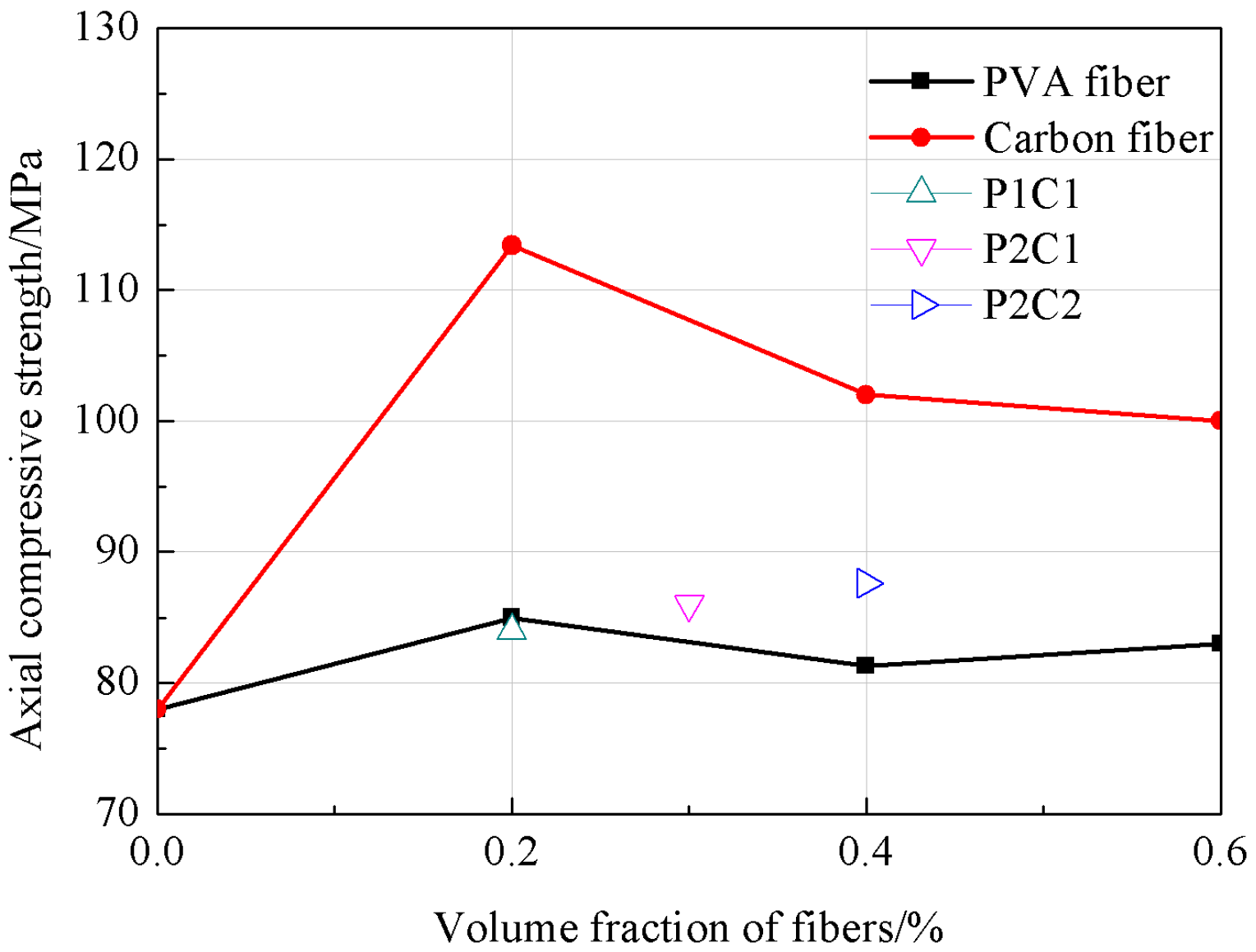
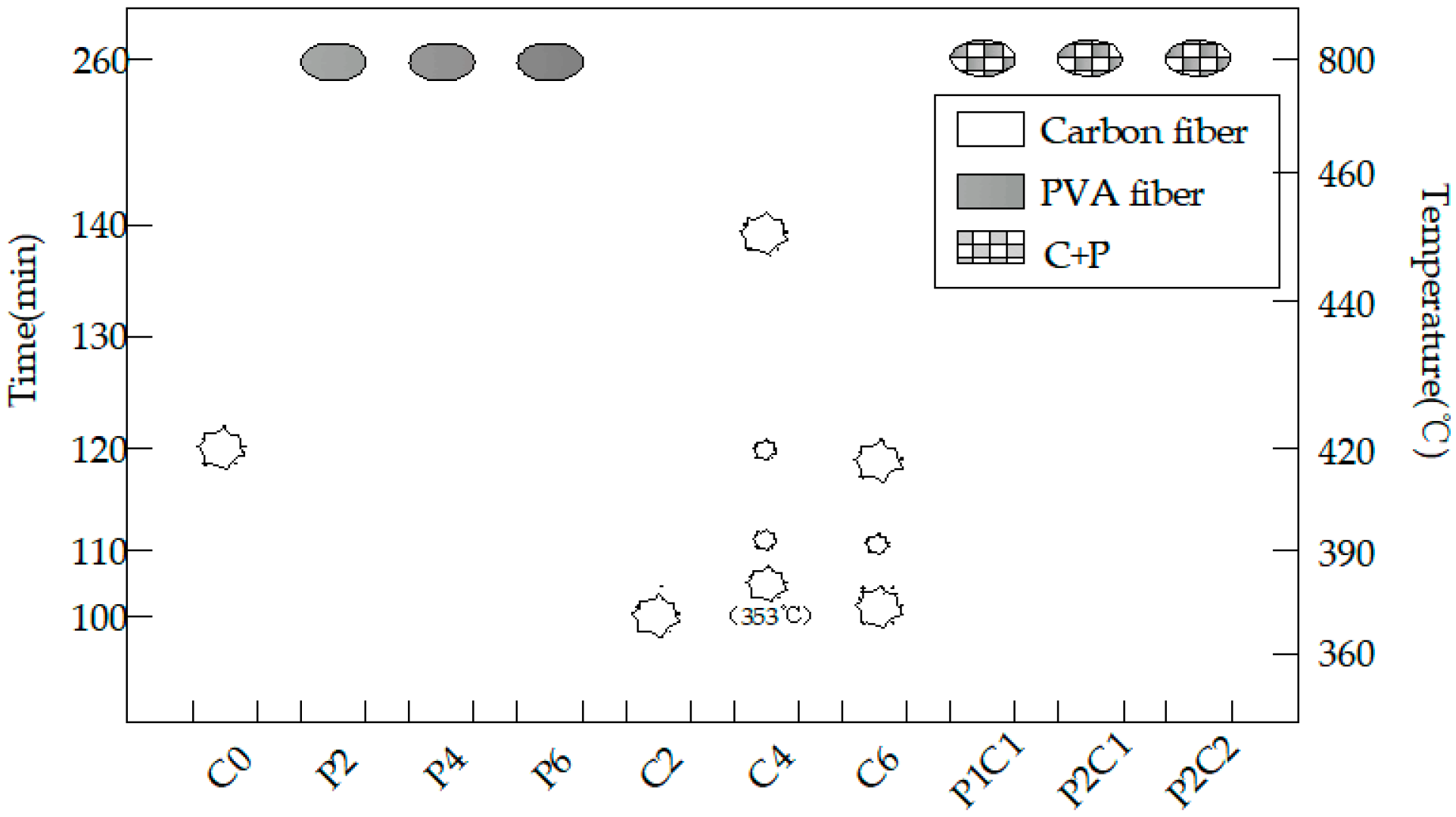
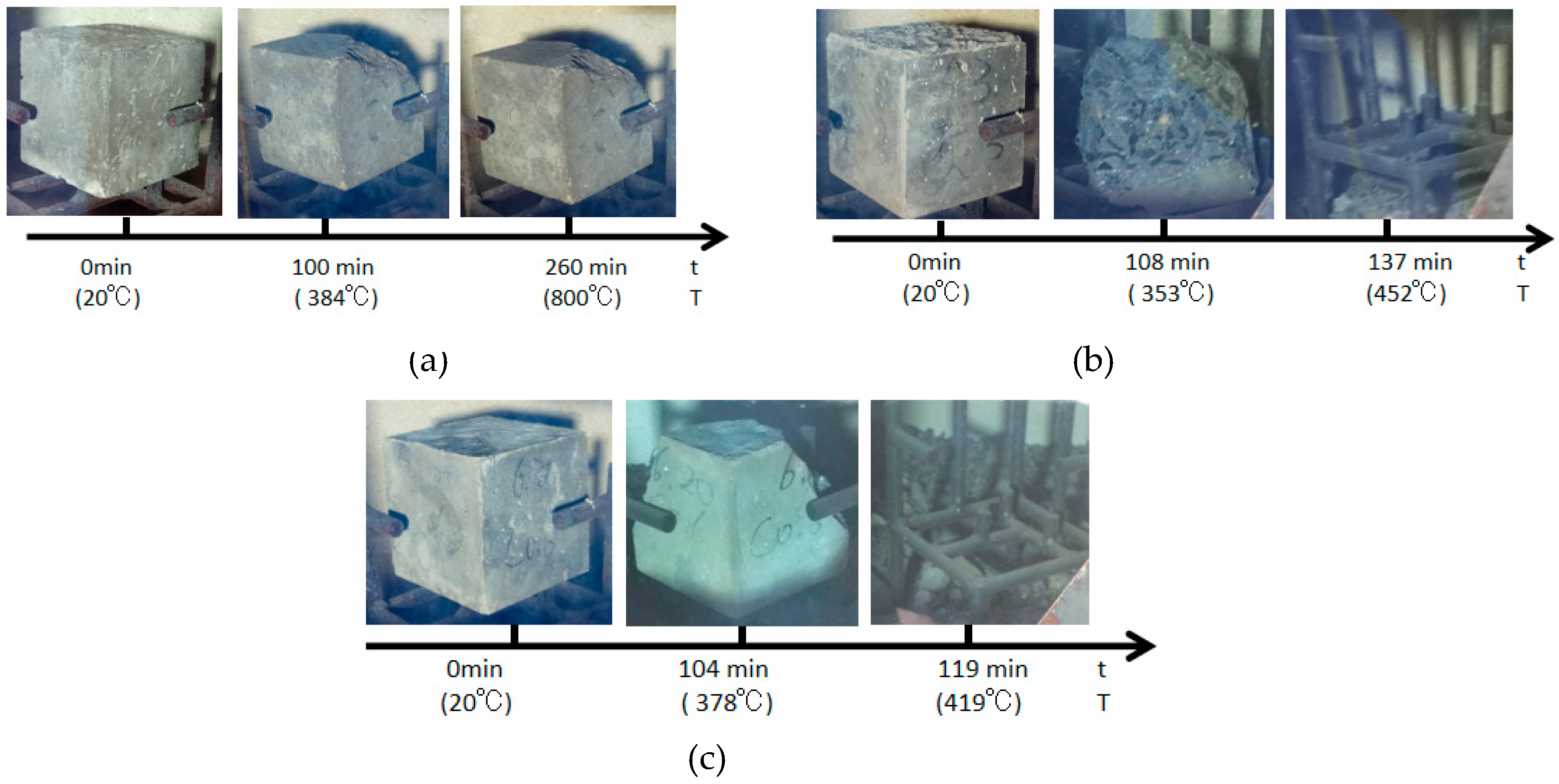

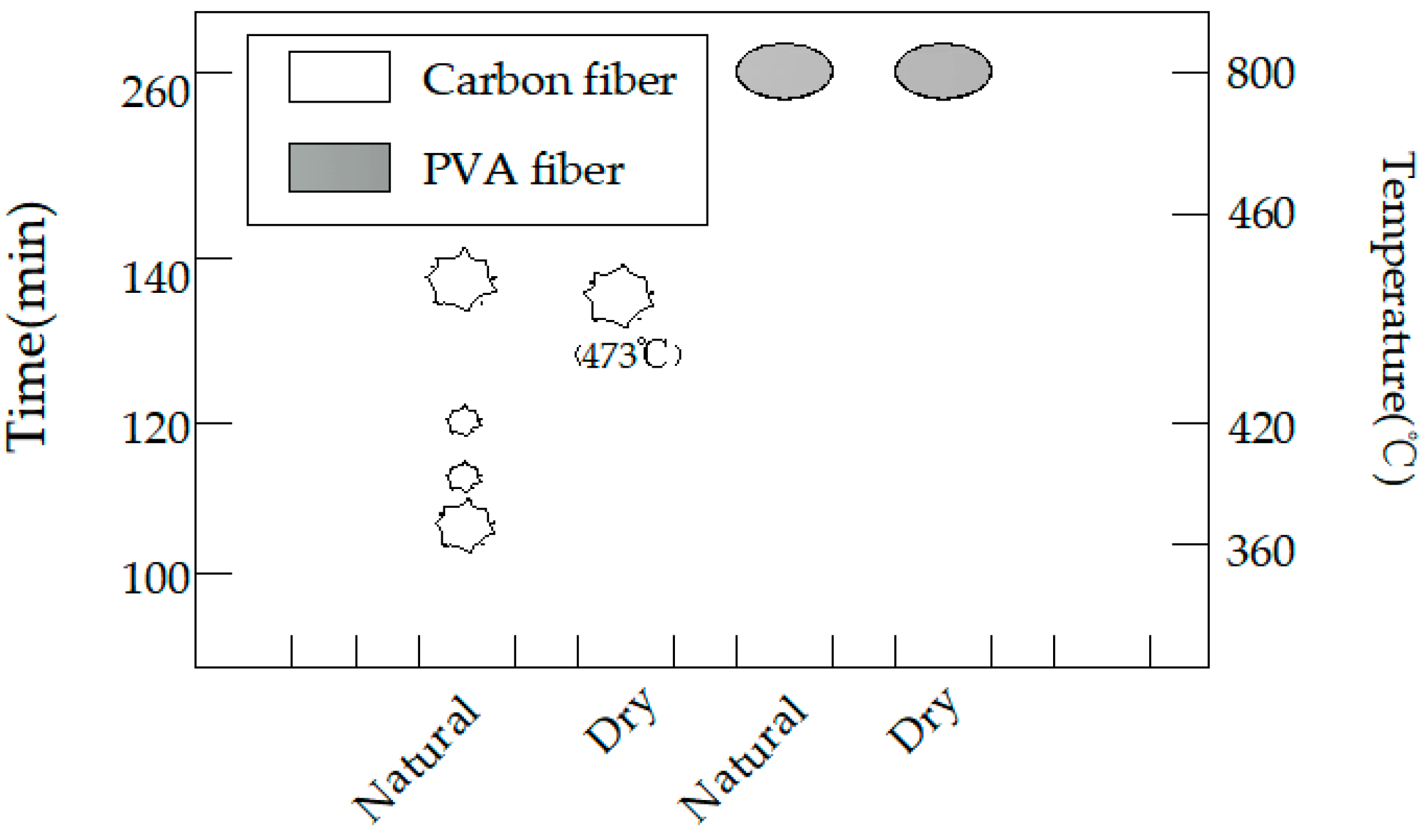

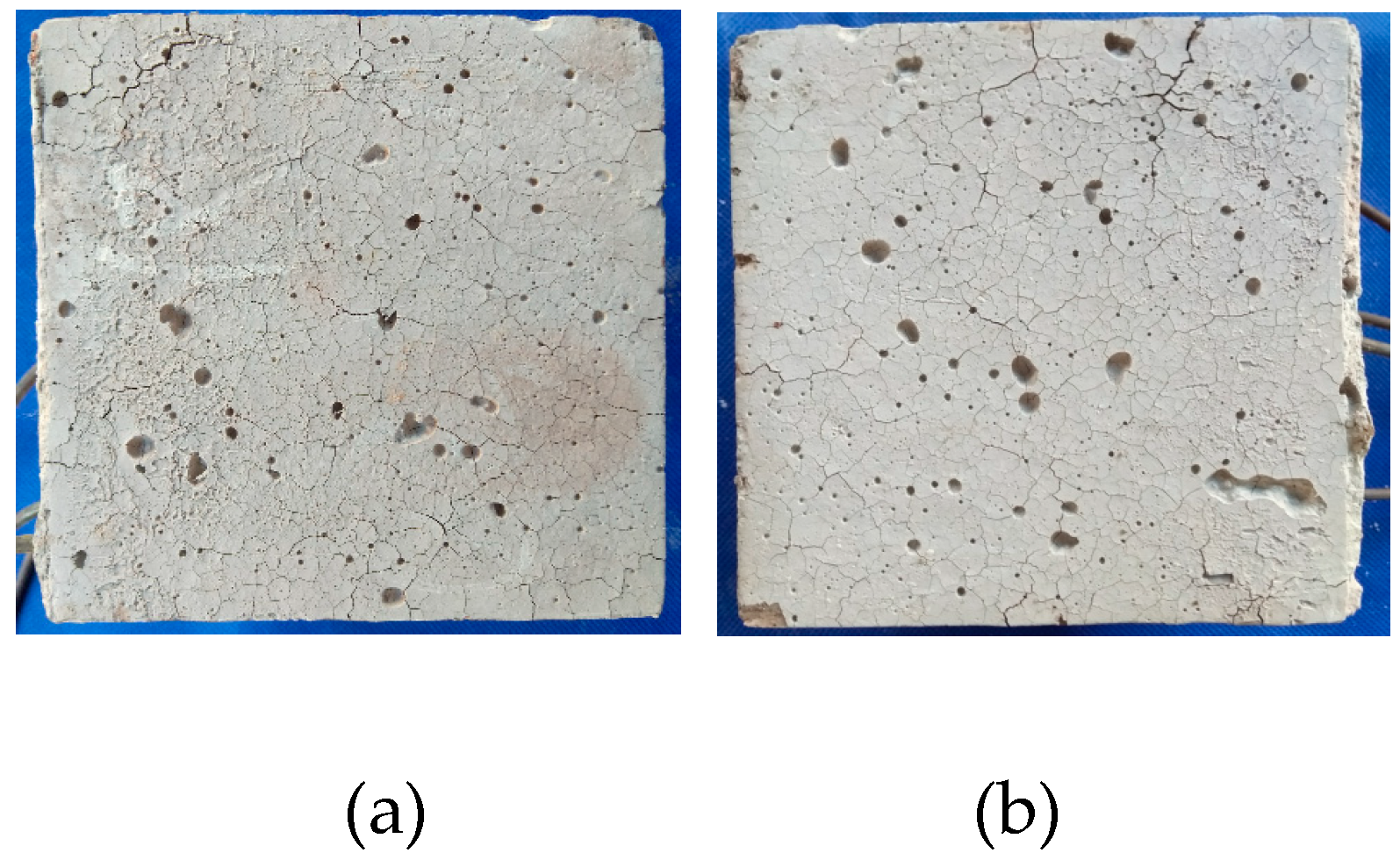
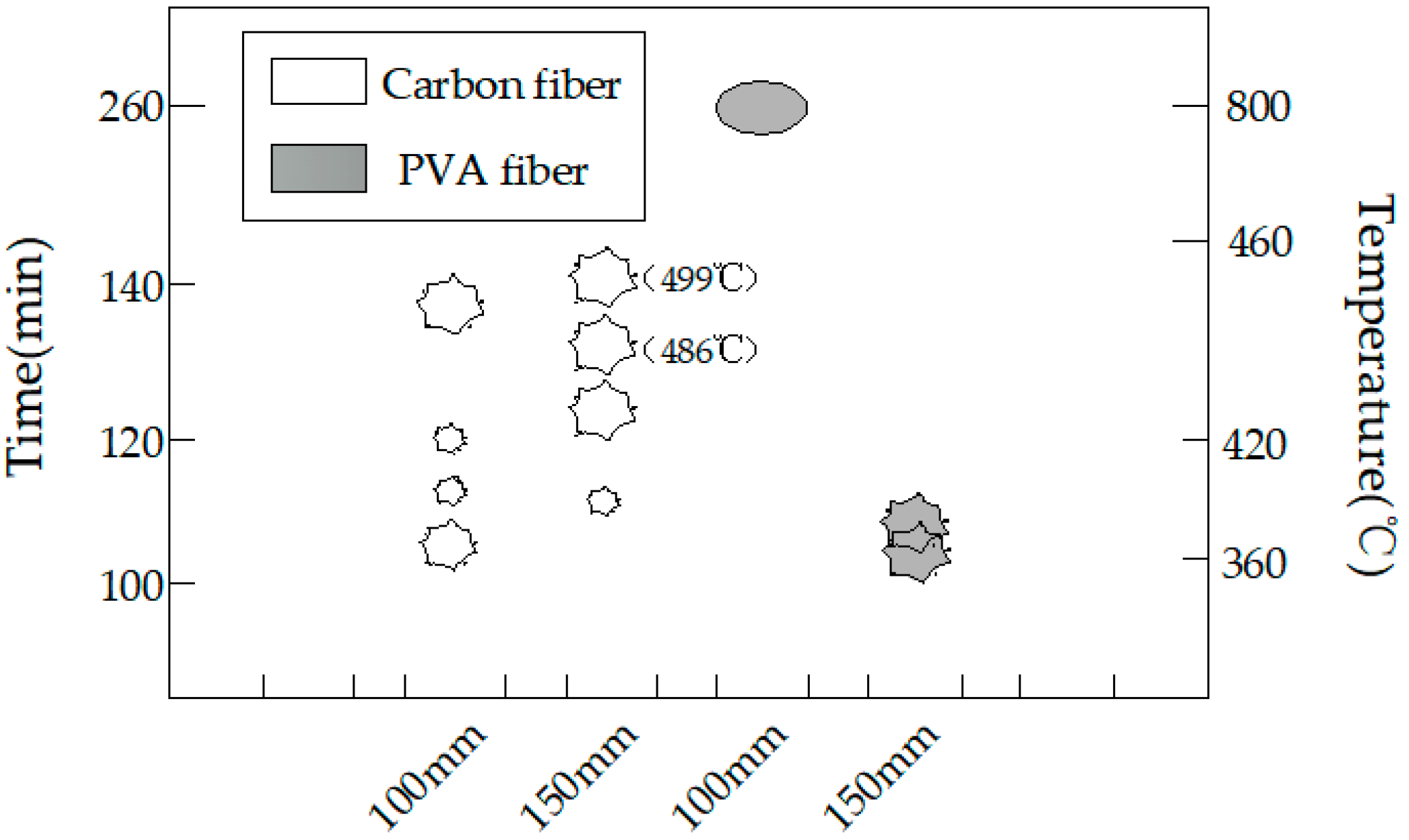


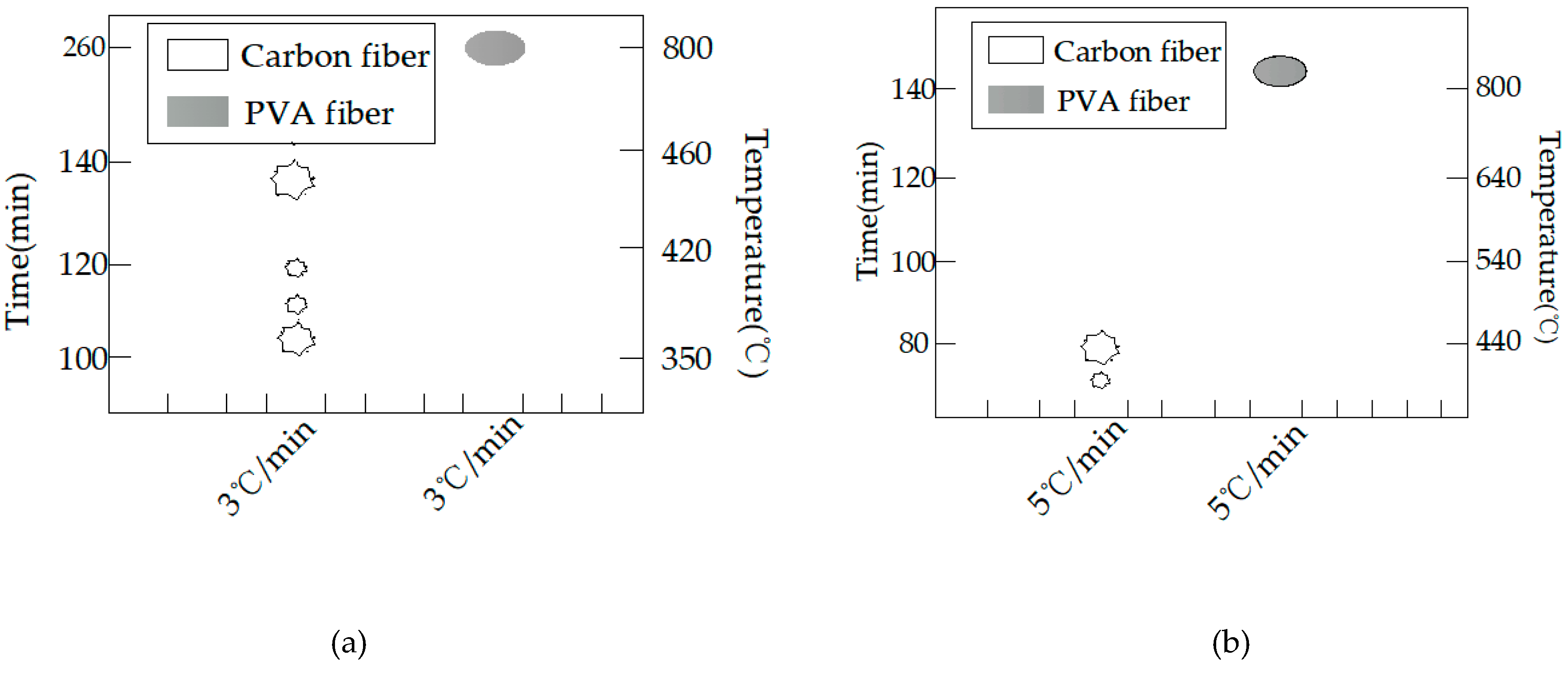

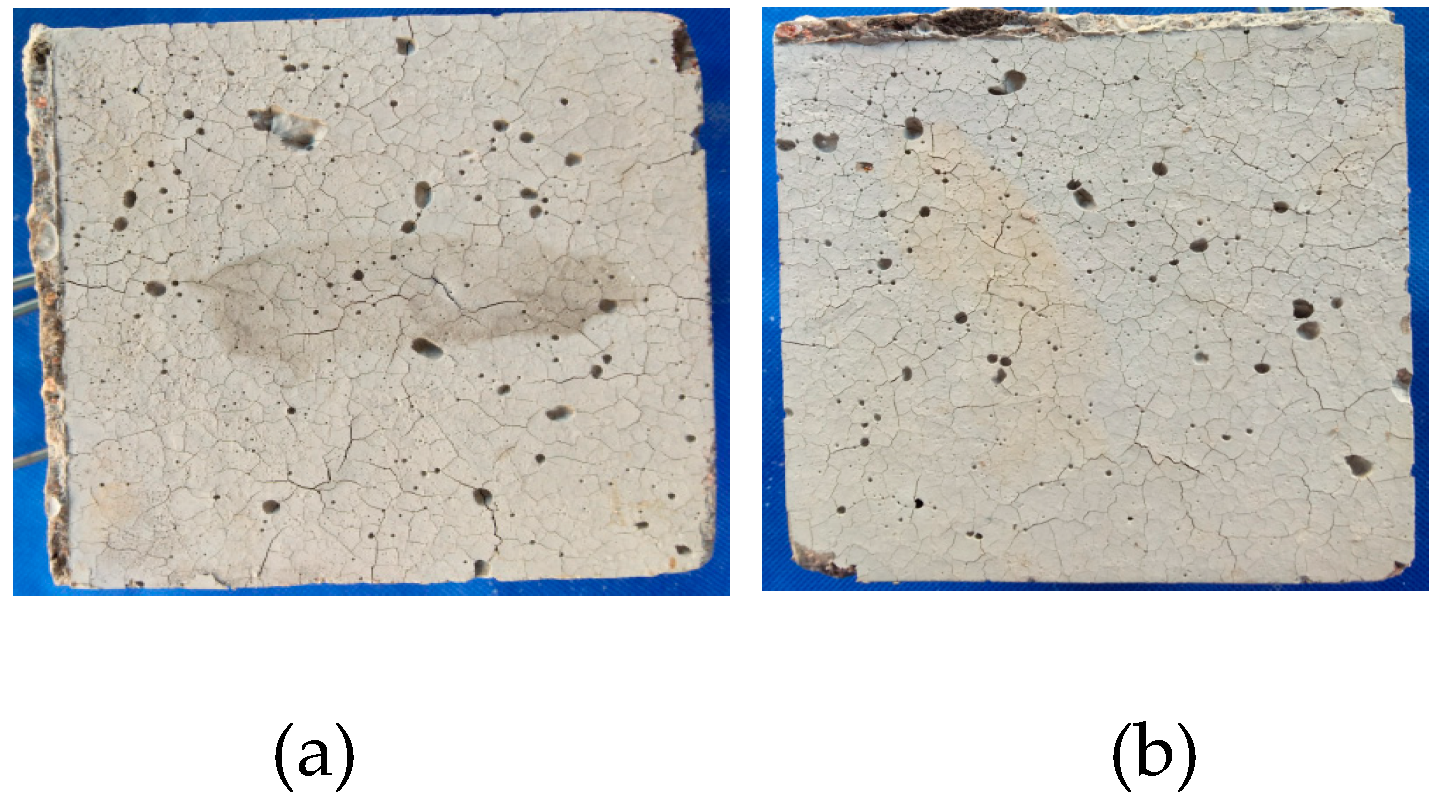

| Materials | Quality (kg/m3) | Volume Fraction of Fibers | ||
|---|---|---|---|---|
| Carbon Fiber (PO) | PVA Fiber (PO) | Carbon + PVA Fiber (PO) | ||
| Cement | 570 | 0 (12.8) C2 (13.41) C4 (14.36) C6 (16.87) | 0 (12.8) P2 (13.32) P4 (14.66) P6 (17.01) | 0 (12.8) P1C1 (14.56) P2C1 (16.93) P2C2 (16.99) |
| Silicone | 60 | |||
| Fly ash | 60 | |||
| mineral powder | 80 | |||
| PO | 12.8 | |||
| Water | 144 | |||
| Fine aggregate | 622 | |||
| Coarse aggregate | 930 | |||
| Properties | Carbon Fiber (C) | Polyvinyl Alcohol Fiber (PVA) |
|---|---|---|
| Specific mass (g/cm3) | 1.98 | 1.3 |
| Fiber length (mm) | 6 | 9 |
| Fiber diameter (μm) | 7 | 12 |
| Melting point (°C) | 3500 | 230 |
| Tensile strength (N/mm2) | 4200 | 1200 |
| Young modules (N/mm2) | 230,000 | 21,000 |
| Test Content | Type | Content | Moisture Content | Size | Heating Up System |
|---|---|---|---|---|---|
| Effect of fiber | C, PVA, C + PVA | 0.2, 0.3, 0.4, 0.6 | Normal | 100 mm | 3 °C/min |
| Effect of moisture content | C, PVA | 0.4 | Dry, Normal | 100 mm | 3 °C/min |
| Effect of heating up system | C, PVA | 0.4 | Normal | 100 mm | 3 °C/min 5 °C/min |
| Effect of size | C, PVA | 0.4 | Normal | 100 mm/150 mm | 3 °C/min |
| Comp (MPa) | Spli (MPa) | Flex (MPa) | Axial (MPa) | |||||||||
|---|---|---|---|---|---|---|---|---|---|---|---|---|
| content (%) | 1 | 2 | 3 | 1 | 2 | 3 | 1 | 2 | 3 | 1 | 2 | 3 |
| 0 | 106.5 | 107.1 | 104.4 | 5.8 | 5.4 | 6.5 | 10.2 | 10.3 | 8.9 | 75 | 81.3 | 77.7 |
| P2 | 100 | 95.4 | 86.6 | 6.0 | 6.2 | 7.1 | 12.2 | 13 | 11.7 | 87 | 87.5 | 80.5 |
| P4 | 88 | 87.2 | 82.8 | 6.4 | 6.4 | 6.6 | 12 | 13.2 | 13.5 | 75 | 82.7 | 86.2 |
| P6 | 86 | 89.6 | 88.4 | 5.9 | 6.3 | 6.9 | 12.2 | 12.0 | 13.2 | 90 | 84.7 | 74.3 |
| C2 | 112 | 116.7 | 110.3 | 9.0 | 7.9 | 8.6 | 14.4 | 13.8 | 15.6 | 110.6 | 115.6 | 114.1 |
| C4 | 98 | 107.7 | 112.3 | 7.7 | 7.9 | 7 | 14.0 | 14.6 | 13.6 | 96.3 | 106.9 | 102.8 |
| C6 | 96.8 | 111.4 | 117 | 6.8 | 7.7 | 6.8 | 13.2 | 13.0 | 12.2 | 94 | 102.9 | 103.1 |
| P1C1 | 101.6 | 97.4 | 89 | 6.7 | 7.4 | 6.9 | 14.6 | 13.6 | 14.9 | 78 | 86 | 88 |
| P2C1 | 96 | 97.1 | 94.3 | 6.6 | 7.4 | 6.4 | 12.6 | 12.3 | 13.5 | 80 | 93 | 85 |
| P2C2 | 84 | 88 | 95 | 7.3 | 7.5 | 6.8 | 12.0 | 12.8 | 12.7 | 94 | 86.7 | 82.1 |
| Type | P0C0 | P0C2 | P0C4 | P0C6 | P2C0 | P4C0 | P6C0 | P1C1 | P2C1 | P2C2 |
|---|---|---|---|---|---|---|---|---|---|---|
| Slump (mm) | 215 | 223 | 210 | 210 | 220 | 215 | 200 | 205 | 211 | 203 |
© 2019 by the authors. Licensee MDPI, Basel, Switzerland. This article is an open access article distributed under the terms and conditions of the Creative Commons Attribution (CC BY) license (http://creativecommons.org/licenses/by/4.0/).
Share and Cite
Cao, R.-d.; Yang, H.-w.; Lu, G.-y. Effects of High Temperature on the Burst Process of Carbon Fiber/PVA Fiber High-Strength Concretes. Materials 2019, 12, 973. https://doi.org/10.3390/ma12060973
Cao R-d, Yang H-w, Lu G-y. Effects of High Temperature on the Burst Process of Carbon Fiber/PVA Fiber High-Strength Concretes. Materials. 2019; 12(6):973. https://doi.org/10.3390/ma12060973
Chicago/Turabian StyleCao, Rui-dong, Hui-wei Yang, and Guo-yun Lu. 2019. "Effects of High Temperature on the Burst Process of Carbon Fiber/PVA Fiber High-Strength Concretes" Materials 12, no. 6: 973. https://doi.org/10.3390/ma12060973





